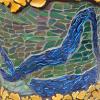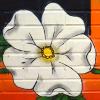Art Notes
Stockholm and Goya

Lee Bontecou's untitled serigraph is on view at the GMOA through Oct. 28.
The Science of Art: With the '60s came a multitude of innovations like lasers, birth control pills, color TVs, computer video games and trans-Atlantic satellite broadcasts that forever changed American culture. The decade also, however, saw major strides in the evolution of art as it moved away from traditional fine art and Abstract Expressionism and refocused on incorporating minimalism and aspects of mass culture into pop art.
In 1966, 10 New York artists set out with a group of engineers and scientists from Bell Telephone Laboratories to develop a collaborative series of dance, music and theater performances, known as “9 Evenings: Theatre & Engineering,” in a groundbreaking effort to incorporate new and emerging technologies into creative media. Experiments in Art and Techonology (E.A.T.) was subsequently founded to further facilitate artist-engineer relationships and to explore the role technology plays in the construction of multi-media art.
When the Moderna Museet in Stockholm, Sweden announced an interest in arranging a collection of works by American contemporary artists a few years later, E.A.T. stepped in to select 30 pieces created by some of the city’s most promising young talents—Roy Lichtenstein, Andy Warhol, Lee Bontecou, Robert Whitman, Alex Hay and Öyvind Fahlström among them—for the “New York Collection for Stockholm.”
To help fund the Moderna’s purchase, each artist was solicited for an original print to include in a fundraising portfolio of the same name, which was then sold in an edition of 300. The Georgia Museum of Art’s recent acquisition, a publisher’s copy of the complete “New York Collection for Stockholm” portfolio, is on display at the GMOA through Oct. 28.
To truly appreciate the collection, it’s essential to recognize its historical context. Using archival film footage, original sound recordings and interviews with artists, performers and engineers, a recent “9 Evenings” film series has reconstructed each of the artists’ performances, shedding light on the legendary series that set it all into motion. Three of these experimental films, Robert Rauschenberg's Open Score, John Cage's Variations VII and David Tudor's Bandoneon! will be shown in conjunction with the exhibit on Thursday, Sept. 20, 6:30–9 p.m., in the museum’s auditorium. Curator Lynn Boland will provide an introduction highlighting the history and goals of E.A.T. and “9 Evenings” prior to the screenings.
A Heroic Feat! With Dead Men!: Long before creating art that reacted to political issues became a largely accepted, possibly even preferred, means of expressing dissent, Spanish painter and printmaker Francisco de Goya (1746–1828) made some of the strongest anti-war statements through his work. “Disasters of War,” an 80-print series of etchings documenting the Peninsular War of 1808–1814, a segment of the Napoleonic Wars during which the French struggled against Spanish, Portuguese and British forces for control of the Iberian Peninsula, presents striking eyewitness accounts of battle while criticizing the tyranny of all monarchies and the clergy for taking advantage of the masses.
Within the series are three thematic groupings that provide a loose historical narrative. The first 47 plates focus on the atrocities of war and the devastating effects witnessing them had on individuals. Each print presents no clear victim or victor, emphasizing the senselessness of battle and that brutality between opponents is equally immoral on both sides. The next 16 plates depict scenes from a horrific famine that ravaged Madrid from 1811–1812. Skeletal bodies with ghoulish faces appear nearly inhuman, stressing the misery of starvation and futility of enduring a war-torn existence. The remaining 17 plates, or “emphatic caprices,” show allegorical, almost nightmarish depictions of human-animal hybrids.
Fearful of political repercussions and censorship, the etchings were not printed until 1863, 35 years after Goya’s death. Although not publicly viewed until long after the war, the series remains as one of the most significant anti-war pieces in history. “Disasters of War” will be on display at the GMOA through Nov. 3.
On the Cover: Ever seen a car plastered in horseshoes, skulls, angels and devils roll through downtown and thought, “What the hell… ?” In lands not so distant, at Farmington Depot Gallery (1001 Salem Rd., Watkinsville) to be exact, the mastermind behind the renowned Heaven and Hell art car, Chris “CHUB” Hubbard, is celebrating over a decade of making folk art with his exhibit, “13 Years of Heaven and Hell.” Influenced by visionary outsider artists like R.A. Miller and Howard Finster, as well as his strong Catholic upbringing, Hubbard’s works employ found materials like tin and wood to construct religious imagery often embellished with painted tongue-in-cheek expressions such as “Thou shall not this, thou shall not that.” Hubbard’s creations will be on display until Sept. 30 during the gallery’s hours, every Wednesday through Sunday, 10 a.m.–6 p.m.
More by Jessica Smith
-

Art Around Town
A list of local art exhibits.
-

-

Art Around Town
A list of local art exhibits.









comments